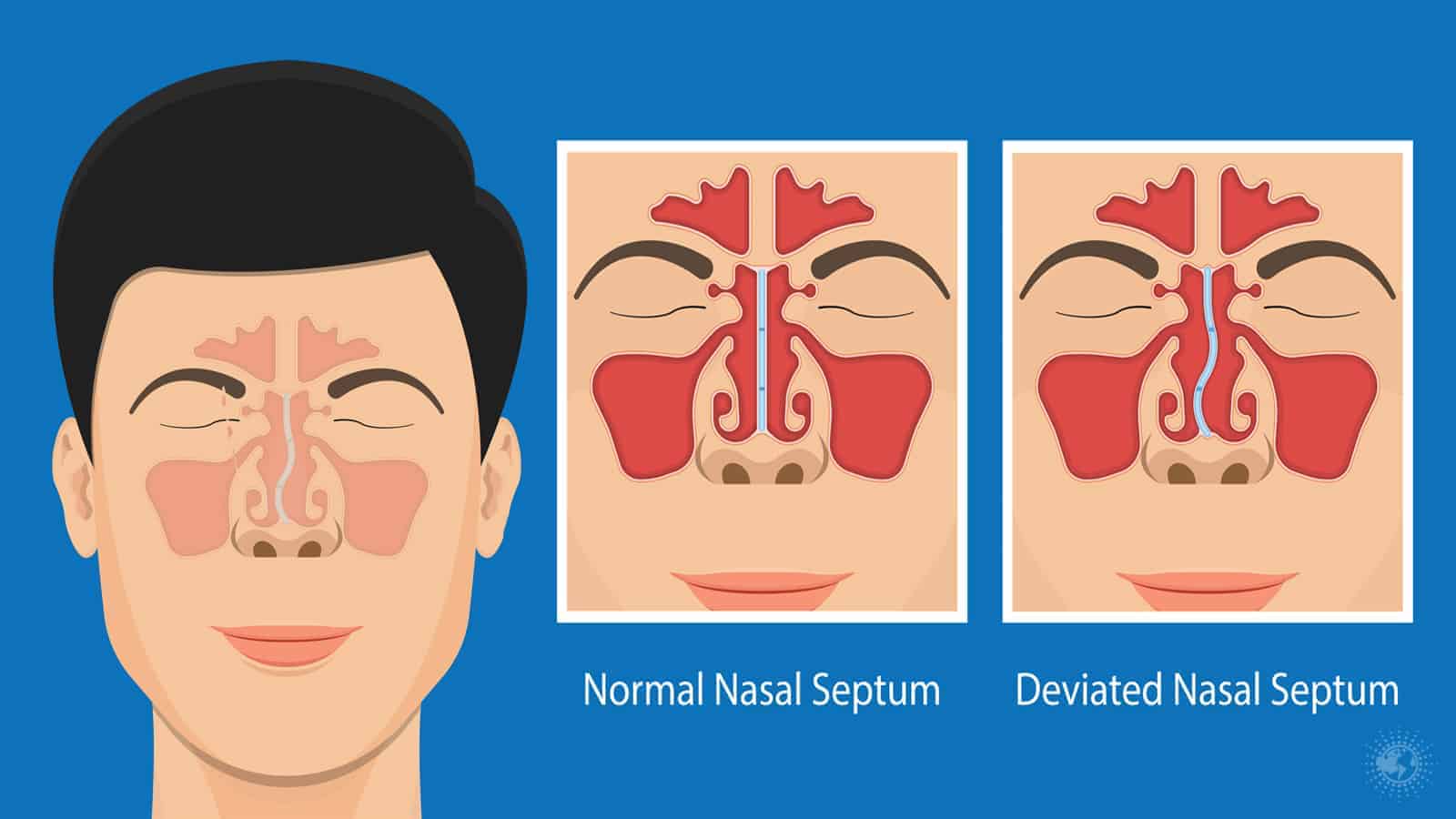Your nose may appear beautiful on the outside, but on the inside, you could have a structural disorder that causes you many problems. Down the center of your nose is a septum made of cartilage and bones, dividing the nose into two sections. The septum runs from the nostrils to the back of your nose.
It should be in a straight line that makes both of your passageways roughly the same size. However, studies show that more than 80 percent of people have disproportionate nasal cavities, which may or may not affect the outside appearance. If your septum is a little off-center, it’s not going to cause too many problems.
However, the real issue comes into play when your septum significantly deviates from its intended shape. The deviation comes from a curve to one side or a shift that causes breathing problems. What causes a deviated septum? It’s most likely a congenital disability. Consequently, it can also occur from an injury, specifically if you broke your nose.
Testing Your Breathing Abilities
To see how well you breathe, you should try a little exercise. Close your mouth and breathe only through your nose. Is it hard for you to pull the air into your lungs? Can you hear rattling as you inhale, trying to move oxygen through your system?
Take your finger and close off one of your nostrils. How much more effort does it require you to take a breath with your mouth closed and only one nostril in use? Now, try this exercise with the other nostril. Can you breathe better out of one side of your nose, or is the airflow even?
If there is a septum deviation in your nose, then it can cause severe breathing difficulties. When the variation is critical, you may be able to see it outside of your body in the form of a crooked nose or abnormally shaped nose hole. Get a mirror and flashlight and investigate your nose cavities.
Do you see a perfectly straight piece of cartilage in the middle, or do you see one side is curved and odd shaped? These simple tests won’t give you a definitive diagnosis. Still, it will tell you if you need further evaluation and see if a septum deviation is a cause for your chronic sinusitis and other breathing issues.
Identifying the Signs of a Deviated Septum Issue
While it doesn’t seem like a massive problem to have a septum that isn’t perfect, it can cause plenty of issues when the alignment is majorly off. Here are some classic signs that you might be dealing with a deviated septum.
1. Frequent Nose Bleeds
The consequences of a septal deviation cause your nose to be drier than usual. As you struggle to get air into your nose, it can make tiny tears in the skin that bleed.
Now, keep in mind that every nosebleed is not from a septum issue, and every septum problem doesn’t cause nosebleeds. However, it’s completely normal to get one of these annoying occurrences with any deviation.
2. Breathing Difficulties
There’s nothing worse than the feeling that you cannot breathe. One of the hallmark signs of a deviated septum is that the obstruction of the nasal passages causes breathing issues. Day or night, breathing through your nose can be challenging.
Most people notice that one side of their nose seems harder to breathe from than the other. It’s often observed on the side that is opposite of the bend. Additionally, one of your nostrils can be blocked off from a severe deviation, which causes the breathing to shift to the other side.
You are trying to get all the air that your body needs from one nostril, and it’s a real challenge. You often see many people with these septum issues breathing through their mouths to take in the required air.
3. Sinusitis
Your sinuses are hollow spaces in the bones surrounding your nose. These little areas produce the mucus necessary to keep things lubricated, and any excess drains from the nose. When a deviation blocks the septum, then the drainage cannot escape the sinuses.
It builds and packs creating the breeding ground for bacteria. Excess mucus sitting in these cavities make you prone to infection. Having fluid in your sinus cavities will make you experience pain and pressure in your forehead, between your eyes, around the sides of the nose, and the cheeks. You can also experience drainage down the back of your throat.
Did you know that sinus problems can cause toothaches, bad breath, coughing, and taste and smell issues? It’s important to note that not every person who has sinus issues is getting these problems from a deviated septum.
Additionally, some people have a deviation issue and don’t experience any sinus problems. If you tend to get chronic sinus infections, then it’s worth having your nose checked out.
4. Headaches
It’s not uncommon to get headaches when the structures within the walls of your nose are affected by your deviation. There are small turbinates or shell-shaped structures in the top, middle, and bottom of the nose.
These little passages help keep the warm air moving through the area and moisturize the space. When you have a severe septum deviation, it can meet these passages and put pressure on them, making them have tenderness and become sore. The pressure can cause you to have headaches, sometimes severe.
5. Disturbed Sleep / Apnea
Has anyone ever told you that you snore loudly? Snoring is often associated with obesity and sleep apnea, but the underlying cause could be breathing problems in your nose. Yes, your nose could be the real issue.
When you have a difficult time breathing through your nasal passageways, you automatically open your mouth to get the oxygen that you need. The open mouth creates a vacuum, and it causes the tissues in your throat to flop around, which makes a lot of noise.
If you hear your infant or young child snoring, then their septum should be evaluated. Sleep apnea is a whole other condition, but it often occurs with a deviated septum too. If you’re waking up regularly, unable to get proper sleep from your lack of breath, then you need to see a doctor.
6. Noisy Breathing
Sleep problems are certainly acerbated during the night, and it doesn’t mean that a severe septum deviation won’t cause daytime issues. The deviation occupies more space than it needs to, which will cause you to breathe improperly through the nose.
You may notice a slight snore while sitting at your desk at work or watching television. While you’re not asleep, the noise is the nose trying to take in adequate air, and the tissues inside are vibrating.
7. Nasal Congestion
Nasal congestion is exceptionally uncomfortable. There isn’t a great deal of space within your nose anyway, and when your septum is an odd shape, it can cause swelling. Your airways can become enlarged and block your breathing.
If you feel like you always have a cold and are fighting to keep your nose opened, it may not be a virus. That stuffy feeling could be from the tissues enlarging from the pressure of the septum. It can be bad enough to stop your breathing in one or both nostrils.
A simple solution is to use a natural decongestant like peppermint or eucalyptus. Allergy medications will also do the trick. They help to reduce the swelling and open these inflamed areas. However, when the medicines don’t seem to work well, it may be a sign that the problem needs medical intervention.
8. Postnasal Drip
As discussed above, the mucus inside your nose may be unable to drain due to the septum. So, the mucus may drip down the throat instead. When the septum affects your sinus drainage, it can cause all sorts of problems.
A little drainage down your throat is conventional, but the defect in your nose may cause the build-up to thicken and become clogged. Not only will you experience tenderness around the sinus area, but you can also have a chronic postnasal drip that causes sore throats and infections.
Final Thoughts: Treating a Deviated Septum
Did you know that your nose droops as you age, which can make problems with your deviated septum more obvious? There may have been no problems before, but once you start getting older, the drooping that occurs can make you have issues that are more pronounced.
There are surgical interventions that can fix this defect, and most take just about an hour or so to complete. The good news is that a simple procedure can fix all these problems without the need for chronic medications and unbearable symptoms. Do you have many of these symptoms of the list? It could be that you have an underlying deviated septum that is to blame.
















 Community
Community

